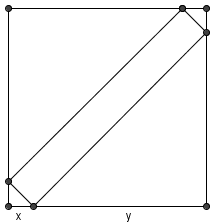Difference between revisions of "2005 PMWC Problems/Problem T8"
(sol) |
m (→Solution) |
||
| Line 5: | Line 5: | ||
[[Image:2005_PMWC-T8.png]] | [[Image:2005_PMWC-T8.png]] | ||
| − | Since the figure in the middle is a rectangle, the isosceles triangles on opposite vertices are congruent. Let <math>x</math> be a leg of the first two, and <math>y</math> the other two. The sum of the areas of the triangle is then <math>2\left(\frac{1}{2}x^2\right) + 2\left(\frac{1}{2}y^2\right) = x^2 + y^2 = 200</math>. ( | + | Since the figure in the middle is a rectangle, the isosceles triangles on opposite vertices are congruent. Let <math>x</math> be a leg of the first two, and <math>y</math> the other two. The sum of the areas of the triangle is then <math>2\left(\frac{1}{2}x^2\right) + 2\left(\frac{1}{2}y^2\right) = x^2 + y^2 = 200</math>. (Remember that the sides are of unequal lengths, so we exclude <math>x = y= 10</math>). Since squares <math>\equiv 0,1 \pmod{4}</math>, we can reduce our search to even integers, and a short bit of trial and error yield <math>x = 2, y = 14</math> works. |
Using subtraction of areas or 45-45-90 triangles, we find that the area of the rectangle is <math>(x + y)^2 - x^2 - y^2 = 2xy</math>; so the area of the rectangle is <math>2(2)(14) = 56</math>. | Using subtraction of areas or 45-45-90 triangles, we find that the area of the rectangle is <math>(x + y)^2 - x^2 - y^2 = 2xy</math>; so the area of the rectangle is <math>2(2)(14) = 56</math>. | ||
Revision as of 11:11, 10 October 2007
Problem
An isosceles right triangle is removed from each corner of a square piece of paper so that a rectangle of unequal sides remains. If the sum of the areas of the cut-off pieces is and the lengths of the legs of the triangles cut off are integers, find the area of the rectangle.
Solution
Since the figure in the middle is a rectangle, the isosceles triangles on opposite vertices are congruent. Let ![]() be a leg of the first two, and
be a leg of the first two, and ![]() the other two. The sum of the areas of the triangle is then
the other two. The sum of the areas of the triangle is then ![]() . (Remember that the sides are of unequal lengths, so we exclude
. (Remember that the sides are of unequal lengths, so we exclude ![]() ). Since squares
). Since squares ![]() , we can reduce our search to even integers, and a short bit of trial and error yield
, we can reduce our search to even integers, and a short bit of trial and error yield ![]() works.
works.
Using subtraction of areas or 45-45-90 triangles, we find that the area of the rectangle is ![]() ; so the area of the rectangle is
; so the area of the rectangle is ![]() .
.
See also
| 2005 PMWC (Problems) | ||
| Preceded by Problem T7 |
Followed by Problem T9 | |
| I: 1 • 2 • 3 • 4 • 5 • 6 • 7 • 8 • 9 • 10 • 11 • 12 • 13 • 14 • 15 T: 1 • 2 • 3 • 4 • 5 • 6 • 7 • 8 • 9 • 10 | ||










